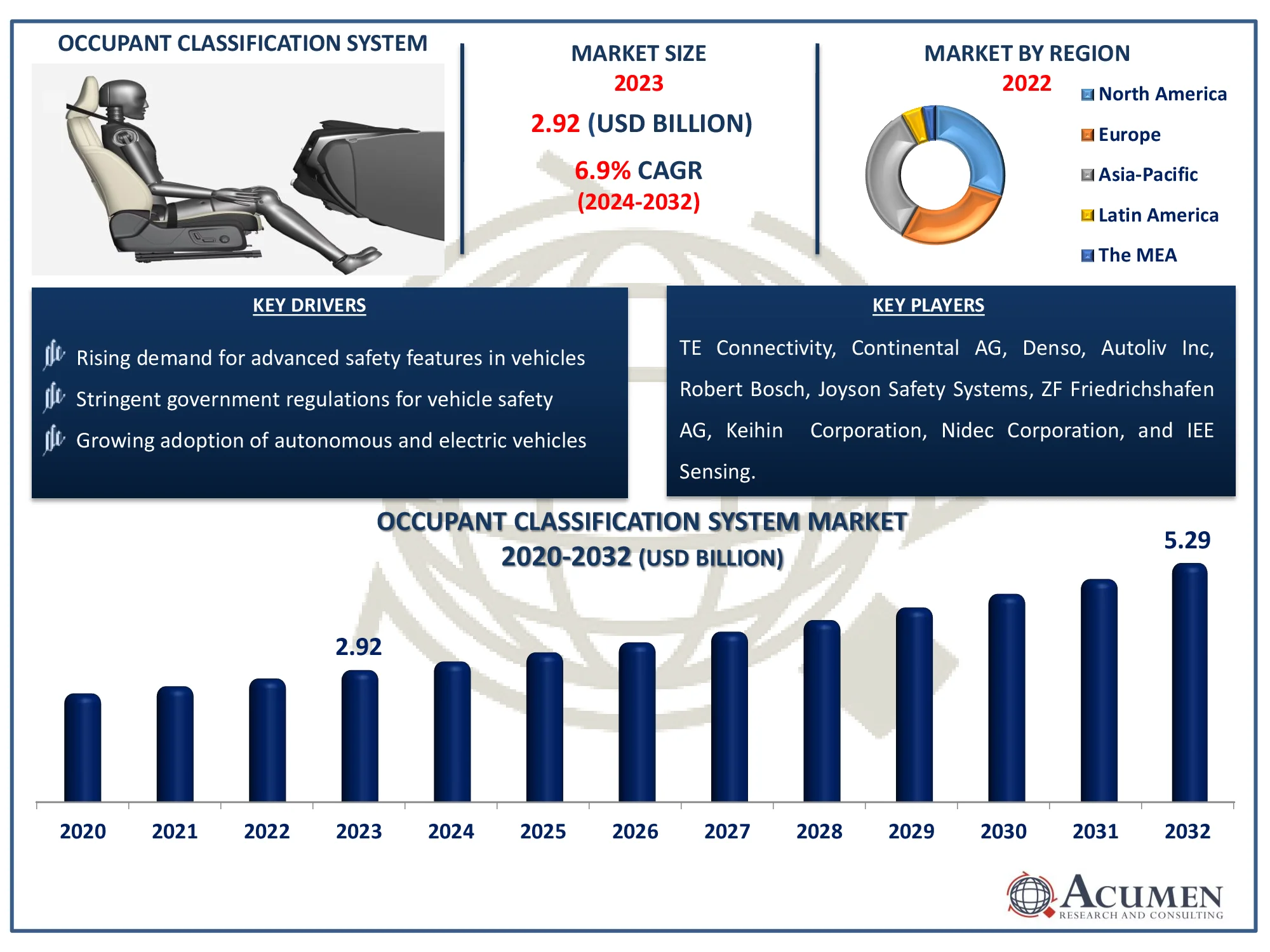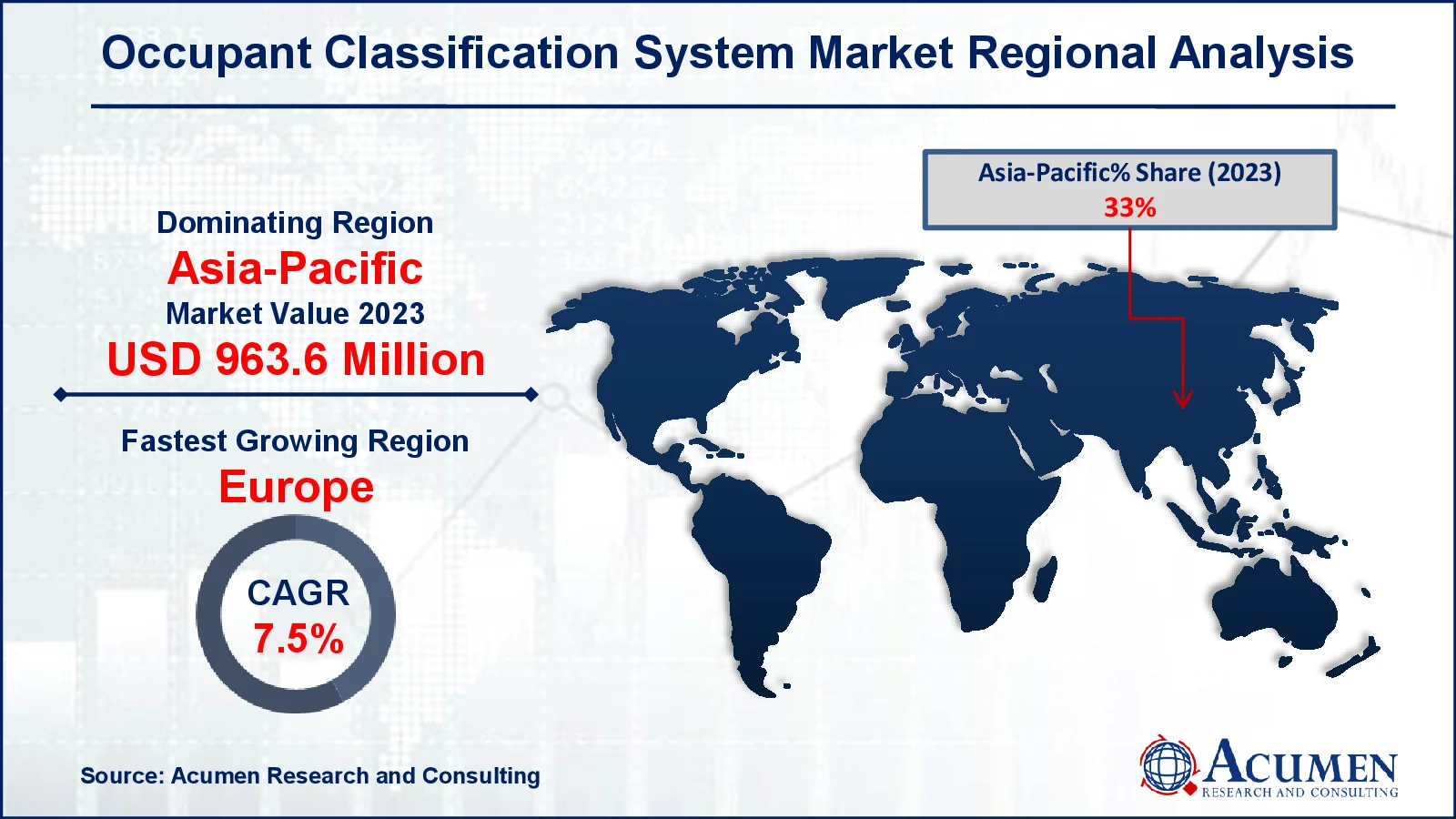Occupant Classification System Market | Acumen Research and Consulting
Occupant Classification System Market Size - Global Industry, Share, Analysis, Trends and Forecast 2024 - 2032
Published :
Report ID:
Pages :
Format :
The Global Occupant Classification System Market Size accounted for USD 2.92 Billion in 2023 and is estimated to achieve a market size of USD 5.29 Billion by 2032 growing at a CAGR of 6.9% from 2024 to 2032.
Occupant Classification System Market (By Component: Airbag Control Unit (ACU), and Sensors; By Vehicle Type: Luxury, Mid Range, and Economic; By Sensor: Seat belt tension sensor, Pressure sensor; By Sensor Technology: Wired, Wireless; and By Region: North America, Europe, Asia-Pacific, Latin America, and MEA)
Occupant Classification System Market Highlights
- The global occupant classification system market is expected to reach USD 5.29 billion by 2032, growing at a CAGR of 6.9% from 2024 to 2032
- In 2023, the Asia-Pacific occupant classification system market was valued at approximately USD 963.6 million
- The European occupant classification system market is projected to experience a CAGR of over 7.5% from 2024 to 2032
- In 2023, the pressure sensor sub-segment accounted for 55% of the market share among sensors
- Based on sensor technology, the wireless sub-segment held a 64% market share in 2023
- OCS technologies are increasingly being integrated with ADAS for enhanced vehicle safety and performance is the occupant classification system market trend that fuels the industry demand

An occupant classification system (OCS) is a car safety feature that detects the presence, size, and weight of a passenger in a vehicle seat. Using sensors positioned within the seat, it determines if the occupant is a child, an adult, or an empty seat, allowing for optimal airbag deployment. OCS improves passenger safety by regulating or deactivating airbags to prevent injury, particularly among children and tiny adults. It is critical in ensuring that safety laws are followed, hence reducing accidents and injuries. OCS technology is largely used in passenger vehicles, including as automobiles, SUVs, and trucks. The regulatory authorities safety rules for passing NCAP test ratings are binding, and they are regarded as a driving force in the market for occupant-type systems.
Global Occupant Classification System Market Dynamics
Market Drivers
- Rising demand for advanced safety features in vehicles
- Stringent government regulations for vehicle safety
- Growing adoption of autonomous and electric vehicles
Market Restraints
- High initial cost of advanced occupant classification systems
- Technical complexity in integrating with existing vehicle systems
- Limited awareness in developing regions
Market Opportunities
- Technological advancements in sensor and AI integration
- Expansion of automotive safety standards in emerging markets
- Increasing focus on occupant comfort and personalization features
Occupant Classification System Market Report Coverage
| Market | Occupant Classification System Market |
| Occupant Classification System Market Size 2022 |
USD 2.92 Billion |
| Occupant Classification System Market Forecast 2032 | USD 5.29 Billion |
| Occupant Classification System Market CAGR During 2023 - 2032 | 6.9% |
| Occupant Classification System Market Analysis Period | 2020 - 2032 |
| Occupant Classification System Market Base Year |
2022 |
| Occupant Classification System Market Forecast Data | 2023 - 2032 |
| Segments Covered | By Component, By Vehicle Type, By Sensor, By Sensor Technology, And By Geography |
| Regional Scope | North America, Europe, Asia Pacific, Latin America, and Middle East & Africa |
| Key Companies Profiled | TE Connectivity, Continental AG, Denso, Autoliv Inc, Robert Bosch, Joyson Safety Systems, ZF Friedrichshafen AG, Keihin Corporation, Nidec Corporation, and IEE Sensing. |
| Report Coverage |
Market Trends, Drivers, Restraints, Competitive Analysis, Player Profiling, Covid-19 Analysis, Regulation Analysis |
Occupant Classification System Market Insights
Automotive manufacturers are increasingly experiencing deaths as a result of car accidents, and the adoption of front airbags has been a key emphasis for automotive manufacturers, leading in the expansion of the occupant categorization system market. For instance, Volvo Buses, a bus manufacturer, will launch new and expanded active safety systems in April 2024 to assist drivers in navigating safely and avoiding potential accidents. These systems include numerous components, with a focus on protecting vulnerable road users including bicycles and pedestrians. Furthermore, various governments throughout the world are pushing the automotive industry to include modern safety technologies into vehicles, further influencing the market. These can help to eliminate and avoid airbag-related injuries, especially in children and small people. Most advanced countries required the implementation of such systems.
Furthermore, the rapid expansion of the automobile electronics sector has benefited the occupants. For instance, according to the India Brand Equity Foundation, India is poised to become the world's largest EV market by 2030. The global EV market was predicted at roughly US$ 250 billion in 2021, and by 2028, it is projected to rise by five times to US$ 1,318 billion. In places like as Europe, people with high availability incomes are becoming more concerned about automobile safety. The industry's growth is predicted to be accelerated by increased awareness of active and passive safety.
Technological developments in sensors and AI integration create a huge opportunity for the occupant classification system market by improving the system's ability to detect and classify vehicle occupants. These enhancements allow for real-time adjustments in safety measures like as airbag deployment based on accurate data about the passenger's size, posture, and weight. AI-based algorithms improve system responsiveness and efficiency, making vehicles smarter and safer. As AI technology advances, it allows for more advanced occupant monitoring systems, such as comfort settings and improved driving assistance.
Occupant Classification System Market Segmentation
The worldwide market for occupant classification system is split based on component, vehicle type, sensor, Sensor Technology, and geography.
Occupant Classification System Components
- Airbag Control Unit (ACU)
- Sensors
According to the occupant classification system industry analysis, the airbag control unit (ACU) is expected to see notable growth because to its vital function in processing input from numerous sensors and making real-time choices concerning airbag deployment. The ACU acts as the central processing unit, interpreting data from sensors such as pressure and weight detectors to ensure optimal safety depending on occupant categorization. Its potential to increase safety measures and vehicle response times under changing situations makes it essential.
Occupant Classification System Vehicle Types
- Luxury
- Mid Range
- Economic
According to the occupant classification system industry analysis, economic vehicles have increased in popularity in regions like as asia and the middle east, where producers are delivering such technologies in affordable cars, owing to the growth of medium-sized populations and discretionary incomes. Luxury car manufacturers have always supported sophisticated and enhanced safety systems as an important component of their business. In addition, luxury car customers continuously want high-level safety systems in their vehicles. This affected the expansion of the luxury car category in the occupant classification system. Automotive manufacturers such as Mercedes-Benz, BMW, and Audi have already incorporated these systems in a variety of passenger car models.
Occupant Classification System Sensors
- Seat Belt Tension Sensor
- Pressure Sensor
According to the occupant classification system market forecast, the pressure sensor is the most popular technology in the market, owing to its dependability and accuracy in detecting occupant presence and weight. These sensors can discern between different occupant sizes by monitoring the pressure exerted on the car seat, which improves safety functions such as airbag deployment. Their ability to perform effortlessly in a variety of environmental situations makes them a popular choice among manufacturers.
Occupant Classification System Sensor Technologies
- Wired
- Wireless
According to the occupant classification system market forecast, wireless technology dominates the market due to its smooth communication and installation flexibility. Wireless systems make it easier to integrate occupant sensors into automobiles since they do not require significant wiring, lowering production costs and installation time. Additionally, wireless technology improves data transfer efficiency, allowing for real-time monitoring and modifications to safety systems.
Occupant Classification System Market Regional Outlook
North America
- U.S.
- Canada
Europe
- U.K.
- Germany
- France
- Spain
- Rest of Europe
Asia-Pacific
- India
- Japan
- China
- Australia
- South Korea
- Rest of Asia-Pacific
Latin America
- Brazil
- Mexico
- Rest of Latin America
The Middle East & Africa
- South Africa
- GCC Countries
- Rest of the Middle East & Africa (ME&A)

Occupant Classification System Market Regional Analysis
For several reasons, the Asia-Pacific is predicted to be one of the leading regions. The Mahindra KUV 100, Toyota Etios, and Maruti Suzuki Desire are among the region's most popular economy automobiles with airbags. Furthermore, some car manufacturers focused on increasing manufacturing activities in the Asia-Pacific region, resulting in an increase in vehicle output. For instance, according to International Trade Administration, China remains the world's largest automobile market in terms of yearly sales and manufacturing output, with local production projected to exceed 35 million vehicles by 2025. According to figures from the Ministry of Industry and Information Technology, more than 26 million automobiles were sold in 2021, including 21.48 million passenger vehicles, a 7.1% increase over 2020. Commercial vehicle sales totaled 4.79 million units, down 6.6% from 2020. Asia Pacific is home to several automakers, including Robert Bosch, ZF TRW, Continental, Hyundai Wia, and other component manufacturers.
Europe is also predicted to be a significant growing market for occupant classification systems. There are high-income European countries with a strong demand for safety features. For instance, adopting priority car safety requirements from 2020 in Argentina, Brazil, Chile, and Mexico could avoid approximately 25,000 deaths and 170,000 serious injuries by 2030. Several luxury automobile manufacturers affected the region's automotive growth. Furthermore, research and development encouraged the integration of vehicles with enhanced safety measures.
Occupant Classification System Market Players
Some of the top occupant classification system companies offered in our report include Aisin Seiki, TE Connectivity, Continental AG, Denso, Autoliv Inc, Robert Bosch, Joyson Safety Systems, ZF Friedrichshafen AG, Keihin Corporation, Nidec Corporation, and IEE Sensing.
Frequently Asked Questions
How big is the occupant classification system market?
The occupant classification system market size was valued at USD 2.92 billion in 2023.
What is the CAGR of the global occupant classification system market from 2024 to 2032?
The CAGR of occupant classification system is 6.9% during the analysis period of 2024 to 2032.
Which are the key players in the occupant classification system market?
The key players operating in the global market are including Aisin Seiki, TE Connectivity, Continental AG, Denso, Autoliv Inc, Robert Bosch, Joyson Safety Systems, ZF Friedrichshafen AG, Keihin Corporation, Nidec Corporation, and IEE Sensing.
Which region dominated the global occupant classification system market share?
Asia-Pacific held the dominating position in occupant classification system industry during the analysis period of 2024 to 2032.
Which region registered fastest CAGR from 2024 to 2032?
Europe region exhibited fastest growing CAGR for market of occupant classification system during the analysis period of 2024 to 2032.
What are the current trends and dynamics in the global occupant classification system industry?
The current trends and dynamics in the occupant classification system industry include rising demand for advanced safety features in vehicles, stringent government regulations for vehicle safety, and growing adoption of autonomous and electric vehicles.
Which sensor held the maximum share in 2023?
The pressure sensor held the maximum share of the occupant classification system industry.



